|
|
Hurry On

|
|
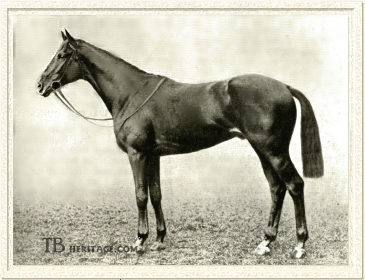 |
|
|
There was nothing in the 1913 chestnut colt's immediate pedigree to suggest he would become a great racehorse. Nor, when, as an overgrown and immature yearling he was put on the block at Tattersall's First July yearling sales, was there anything to indicate he would later become a high-class, influential sire. Still, there was something about the lanky youngster that the twenty-five year old trainer, Fred Darling, recently back from the training post at the Oehringen stable near Vienna, saw, and he bid 500 guineas, well above the average price of 389 guineas for the 84 colts sold that week, but significantly below the four-figure sums offered for offspring of more popular sires.
Darling was acting as agent for distillery magnate James Buchanan (later Baron Woolavington), who had had his horses in training with Fred's father, the prominent trainer Sam Darling. Sam Darling had retired in January of 1914, turning over the reins of his Beckhampton stable to Fred. Darling senior had turned out over 200 winners from Beckhampton since 1896, including such horses as Derby winners Ard Patrick and Galtee More. His son, during the course of his subsequent forty-plus year career as a trainer, and later breeder, schooled seven Derby winners and numerous other classic winners. Two of Fred Darling's best classic winners, Captain Cuttle and Coronach, were sons of that overgrown colt, named Hurry On.
Buchanan was no novice on the turf, but he had not had major success, his best horses to that time being Black Sand, who won the Cesarewitch and Jockey Club Cup in 1902, and Mountain Apple, unbeaten at age 2 in 1907. That luck, too, would change with the purchase of Hurry On and his subsequent successes on the turf. After his retirement to Buchanan's Lavington Stud in Sussex, Hurry On sired Captain Cuttle and Coronach for Buchanan, and other classic winners and top races horses for other owners. The awkward yearling, the young trainer and the ambitious owner became a trio that impacted racing in Great Britain for years to come.
Hurry On's dam, the Sainfoin daughter Tout Suite, and her granddam, Star, by Thurio, were both bred by Prince Soltykoff. Thurio had won the Grand Prix de Paris and other good distance races. His daughter, the chestnut Star (1887), was out of the Thuderbolt daughter Meteor (1867), and so half-sister to some good runners, including Radiancy, a good runner and dam of the good stayer Sheen, and Mask, who ran third in Bend Or's Derby and won the July Stakes. However, Star won only twice in her four seasons on the turf, once at age two, and once at age four, when she won a £1000 plate over two miles, receiving 22 pounds from Queen's Birthday. During her three year old season she was persistently placed in races beyond her class, but managed to run second twice to Oaks and St. Leger winner Memoir, and once to St. Serf. Her racing career showed she had stamina, even if she was not a top class filly. Tout Suite was born in 1904, the year Soltykoff died, and she and Star were sold to a Mr. de Wend Fenton for 80 guineas.
As a yearling Tout Suite was sold at Lingfield sales to William Murland, an Irishman who lived at Badby House, near Daventry, Northamptonshire, who had, when younger, been a successful jump jockey, having won the Irish Grand National on Billet Doux in 1885 and the Conyngham Cup on Belmont in 1884. Murland operated a small stud at Badby House, with no apparent desire to breed to fashionable stallions. It isn't known what caused him to purchase Tout Suite; she was barely taller than a pony and so backwards, she was never raced. Her sire, however, was Derby winner Sainfoin, a popular stallion whose son, Rock Sand, had won the Derby the year before she was born. Murland sent her to the big, handsome chestnut --and most definitely unfashionable stallion -- Marcovil, in 1912, and in 1913 she dropped Hurry On, her fifth foal. A year later, Hurry On was on the block at the Tattersall's sale.
|
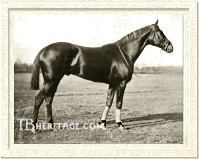
Marcovil
| |
Marcovil, born in 1903, was one of Marco's lesser sons on the turf. He, too, was big at age two, and although he ran second by a length and one-half to Lally in the 6 furlong Richmond Stakes that year, he was troubled by a tendon from the time of that race until his retirement. He ran only once more at age two, unplaced in the Middle Park Place stakes at Newmarket. He came out twice at age three, bothered by his tendon, and won a one mile Maiden Plate at Kempton, worth £132. |
At age four he won two of his three races, a Welter Handicap at Newmarket over 7 furlongs, and the Alexandra Handicap at Gatwick at the same distance; he placed second in the Great Jubilee Handicap over 1-1/4 miles at Kempton, beaten one-half length by Polar Star, the only time he showed he could go a distance.
Sold after the death of his owner-breeder, the Duke of Devonshire, in 1908, Marcovil was purchased by Francis Luscombe, the owner of his sire, Marco, for 930 guineas; Luscombe intended him as a replacement for Marco, but he kept Marcovil in training for the rest of the season, in the hope of establishing better credentials. At age five, then, Marcovil won the Cambridgeshire Stakes over 9 furlongs, his best win, after which he was retired.
Luscombe sent him to stud at Egerton House at Newmarket with a stud fee of £25. Tout Suite arrived at his court his fourth year, when he was standing for £45; that year, 1912, he had his first winners -- four -- each of which won one small race. He was never a particularly successful sire, but he got a lot of winners of smaller races over the course of his stud career. In 1916 their total earnings, boosted by Hurry On's unbeaten three year old season, pushed Marcovil up to seventh in the leading sire lists, the highest he ever achieved. More than half his winners did best at age two. In addition to Hurry On, he got the big 16.2 hand colt, My Prince (1911, out of Salvaich), who won three races -- the Union Jack Stakes, the Tudor Plate, and the Gordon Stakes at Goodwood, beating some decent horses in the latter race. At stud in Ireland, My Prince got a number of modest winners on the flat, but his value was in the great steeplechasers he sired --the Grand National winners Reynoldstown (1917), Gregalach (1922), and Royal Mail (1929) -- the great Easter Hero (1920), and the Cheltenham Gold Cup winner Prince Regent (1935).
Some of Marcovil's daughters proved extremely useful in the stud: Miss Matty (1914) was the dam of Derby winner Papyrus, and Marveld, a filly from the same crop, produced Mondovi, a good winner in France and his half-sister Mackwiller, who won the French 1,000 Guineas and was tail female ancestress of a number of good horses, including the stallion Vimy, and 1,000 guineas winners Mesa and Ma Biche. Another daughter, Sold Again, was second dam of Derby winner April the Fifth. Marcovil died unexpectedly at Heath Stud, Newmarket, in 1917, put down in February after suffering from a mysterious paralysis of his hind end.
Hurry On on the Turf
Hurry On was not started at age two, and Darling waited until the middle of June of his three year old year to run him in his first race. Even at age three, he was still growing, and despite win after win that season, he was considered by many to be coarse and clumsy. His first race was a £100 Maiden plate over a mile at Lingfield, which he won easily by two lengths over 15 other horses. His next race was the Stetchworth Plate at Newmarket over 1-1/2 miles, another two length victory. He followed that by a win of the 1-1/4 mile Newbury Stakesin August, winning by three lengths, beating the 1,000 Guineas winner Canyon by eight lengths. His next race was the September Stakes at one and three-quarter miles, in which he beat the 2,000 Guineas winner Clarissimus in a canter by three lengths, and three others. He followed that by two easy victories: in the St. Leger Stakes over 1-3/4 miles, held that year at Newmarket due to wartime restrictions, he won by two lengths, and the 2-1/4 mile Jockey Club Cup at Newmarket over 2-1/4 miles was a ten length win for him. This was his last race, and in his one-year season, he was headed only once, when he got off to a slow start in his first race. Late in his highly successful career Fred Darling said "He is the best horse I have ever trained, and the best I am ever likely to train."
Hurry On in the Stud
Hurry On eventually reached 17 hands, with a frame and legs proportionately powerfully shaped. He was a horse of apparently limitless stamina, and he largely passed this trait, along with his size and his "fierce" disposition, on to his offspring. He sired seven classic winners, including three sons who won the Derby, and Precipitation, an excellent staying son, who despite not contesting the classics, was rated third in the Free Handicap. It was through Precipitation, sire of four English classic winners and a great many more top class stayers, that the sire line continued. Two Hurry On sons became sires of top steeplechasers, and one daughter produced a Grand National winner. He was the grandsire of winners of the Arc de l'Triomphe, the Melbourne Cup, and the Doncaster Cup, all premier tests of stamina, as well as of Saint Leger, Derby, Oaks and Guineas winners and of multiple classic winners in Italy and South America.
Hurry On was leading sire once in Great Britain, in 1926, the first time in 69 years that a Matchem sire line descendant headed that list; the winnings of his progeny that year -- £59,109 with fourteen winners of twenty-six races -- catapulted him into the third spot of best leading sires ever in Great Britain, behind Stockwell (£61,391) and St. Simon (£59,740). In 1922, Captain Cuttle's Derby year -- with eleven winners of twenty three races worth £32,065 -- he had been narrowly beaten into second place on the list by Lemberg.
His first crop was born in 1919, and in 1921 as two year olds, they didn't make much of a mark, with Invergarry, a filly, being his only winner of two races. The following year, when his first crop ran as three year olds, his statistics jumped dramatically, to eleven winners of twenty-three races, and, as stated earlier, earned him a spot at second in the leading sires list. From then until 1930, competing with such stallions as Phalaris, Swynford, Gainsborough, Son-in-Law, Pommern and Sunstar, he was never out of the top ten, and was second again in 1927, and twice third (1928 and 1929).
|
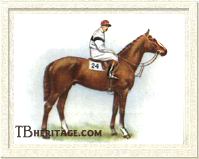
Captain Cuttle
| |
CAPTAIN CUTTLE, "the best looking horse seen on the British Turf in generations," was born in 1919, the product of one cover of his dam, the Cyllene daughter Bellavista. She was the first mare ever put to Hurry On, purchased by Buchanan for 1,950 guineas when she was fifteen years old in 1915. She had won £2,700 on the turf, and had been a productive broodmare, but her best was her first foal by Hurry On. Like his sire, Captain Cuttle was a backward colt, and ran only once at age 2, Darling adopting a similar strategy to that he followed with Hurry On. In that race, the 6 furlong Rous Plate at Doncaster, he ran second.
|
He started favorite for his next race at age 3, the Wood Ditton Stakes at Newmarket, which he won in a canter by six lengths. He ran third in the 2,000 Guineas to the surprise winner, St. Louis, and Pondoland, and while it was bruited about that he had no stamina (!), it was later revealed he had been sick in the time between his Newmarket win and the 2,000 Guineas. That lack-of-stamina rumors were put to rest when he won the Epsom Derby by four lengths in record time of 2 minutes and 34-3/5 seconds. He won his next race, the St. James's Palace Stakes over a mile, but developed tendon trouble, attributed to the hard surface of the turf during the Derby, and was withdrawn from the St. Leger. At age four he easily won the Prince of Wales's Stakes at Kempton, and was intended for some of the big handicap races that year, but his tendon trouble resurfaced, and he was retired to stud next to his sire at Lavington.
He spent five years at Lavington. His best offspring on the turf was the filly Scuttle, who won the 1,000 Guineas and a total of 5 races worth £11,800. His other good runners included The Recorder, Mint Master, and Walter Gay, the latter second in the Epsom Derby. He was clearly not up to the standards of his sire as a stallion, with youngsters winning 69-1/2 races and £37,037-1/2 in six years, and he was sold to Signor R. Gualino in 1927, and shipped to Italy following the 1928 stud season. He had a very short career there, breaking his back in a freak accident at Mirafiori Stud in 1932. Despite this, he sired one really good horse in Italian Derby winner Pilade (1930), who won the Gran Premio del Jockey Club, among other races, who in turn got an Italian Oaks winner, Zamora, and a top steeplechaser, Gong, who won the Gran Premio di Merano in 1948; a Pilade daughter, Trau, also produced a Gran Premio di Merano winner in her son, Spegasso. Pilade was later shipped to Poland, where he was champion sire several times in the 1950s. |
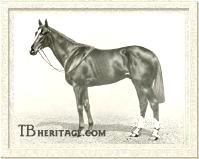
Coronach
| |
CORONACH was another big, 16. 2 hand, handsome chestnut son of Hurry On's, born in 1923, out of the Tredennis mare Wet Kiss. Wet Kiss, bred in Ireland in 1913, was out of Soligena, a mare in-bred to St. Simon whose difficult temperament made her impossible to train. Her full brother, Soldennis, was a very good race horse who won the Irish 2,000 Guineas and won 25 races in all in 5 years on the turf. Wet Kiss eventually ended up with the partners de Mestre and Higgs, for whom she won two nursery races and then ran fourth to Fifinella in the Oaks.
|
She was purchased by Lord Woolavington (Buchanan was made a Baron in 1920) in foal to Pommern; that filly failed to win. Her next, Miss Marget, by Hurry On, won four modest races; the following youngster, also a filly by Hurry On, died as a yearling, and the next year she slipped a foal to Hurry On. Coronach was her fifth live foal. Like Hurry On and Captain Cuttle, trainer Fred Darling took him to hand for Baron Woolavington.
Coronach was the co-champion two year old in England, with a win in his first race, a Maiden Plate at Bibury in early July, followed by wins in the Rous Memorial Stakes and the Champagne Stakes, in the latter beating a top class field by two lengths. He lost by a neck to Lex, a good, but not great juvenile (third in the Free Handicap), in the Middle Park Stakes, but right after the race he had a temperature and was sick for several days. That was the end of his two year old year.
At age three he came out first for the Column Produce Stakes at Newmarket, which he won easily. Next was the 2,000 Guineas, where he astonished the racing crowd by being beaten into second place by Colorado; Fred Darling later said his being left by the post, and by the time he made up the three length lead he was, "naturally a rather backward horse," "exhausted...for he never had a chance to take a breather." Coronach entered the Derby with a cloud of suspicion hanging over his ability to stay, but he redeemed himself by easily winning by five lengths, beating Lancegaye and Colorado and 16 others on a soggy track with poor visibility due to constant drizzling rain. Like Captain Cuttle, he went on to win the St. James's Palace Stakes at Ascot. He then triumphed in the Eclipse Stakes by six lengths, and finally the St. Leger Stakes at Doncaster, besting a field of twelve by two lengths.
At age four he showed increasing signs of respiratory problems. Despite this, he won the Coronation Cup, beating Embargo and Foxlaw, later winner of the Ascot Gold Cup. His next race was the Hardwicke Stakes, which he won by 12 lengths, his final triumph. In his last two races, his constitution broken by his wind infirmity, he ran eight lengths behind Colorado in the Princess of Wales's Stakes, still placing second, and then was the last of three horses to run in the Eclipse Stakes, beaten by seven lengths by Colorado.
Coronach was also retired to stud at Lavington, where he proved to be a disappointment, at least as far as English bloodstock is concerned. His best horse in England was Montrose, a game winner of 13 races, including the City and Suburban, who retired to stud in Ireland. Montrose's progeny were sold to South Africa, and his stock was so popular there that, while standing in Ireland, he was a leading sire of winners in South Africa. Another good son in England was a gelding, Highlander, which won £6,123.
However, several astute breeders on the continent sent mares to Coronach at Lavington, and wins of his youngsters there pushed him to third in the leading sires list in France, and he was twice in the top ten leading sires lists in Italy. One of these breeders was the French breeder Marcel Boussac, who sent his excellent producing mare Zariba (dam of Abjer, Goya II, Goyescas), by Sardanapale to Coronach. The result of that breeding was the outstanding race filly Corrida (1932), who won top races in four countries, including the Prix de l'Arc de Triomphe, twice. She ran to age five, a great staying mare of good speed, and retired with winnings of £47,000. In the stud she only got two foals, one dying early in an accident; the second, Coaraze, won the French Derby and was a good sire in France before his export to Brazil, and one of his sons there, Emerson, unbeaten winner of the principal classic races in Brazil was later sent back for stud duty in France.
Another good filly on the continent for Coronach was Jacopa del Sellaio (1929), who won all the Italian classics, save the Italian St. Leger, and was champion of her generation in Italy. She was out of Vice Versa, by William the Third, a mare owned by Federico Tesio. Her closely-related half brother, by Captain Cuttle, Jacopo da Pontormo (1932) won the Grand Premio d'Italia.
Coronach's son, the French-bred Cranach (1938), from the Blandford daughter Reine Isaure, was taken at age 2 by the Germans during World War II, and won eleven races during his tenure there. Repatriated after the war, he was a good sire whose winners included the very good stakes winner Violoncello, and the French St. Leger winner Ciel Etoile. His daughter, Flute Enchantee, won the Grand Prix de Deauville, and in the stud produced Luthier, a top runner in France who later became four times leading sire, and twice leading broodmare sire.
Another Coronach son, De Albertis, won in Denmark and became a leading sire there.
From the same crop as Cranach (1938), Coronach sired Niccolo dell'Arca, again out of a Tesio-owned mare, the great producer Nogara, dam of his half-brother, Nearco. Niccolo dell'Arca ran and won in both Italy and Germany; he won the Italian triple crown and was champion of his year there. In six years at Tesio's Dormello stud, he got Italian Derby and St. Leger winner, Daumier, who was later sent to the U.S. for stud duty, and the great filly Astolfina, which won the Italian 1,000 Guineas, the 2,000 Guineas and the Italian Oaks. He also got the filly Buonamica, who later was the dam of Botticelli and Braque, and the good Italian race filly Trevsina, winner of the Gran Criterium, the Gran Premio d'Italia and the Italian St. Leger, among other races. Niccolo dell'Arca was later sold to Englishman Clifford Nicholson, and was sent to Nicholson's Lincolnshire Limestone Stud, where he sired Doncaster Cup winner Nick La Rocca (1949), and Bebe Grande (1950), the brilliant, top juvenile filly of her generation in England. The latter's brother, Nicholas Nickleby, was also a good winner of twelve races, including the Royal Hunt Cup and the Newbury Spring Cup. Not particularly popular in England, Niccolo dell'Arca was leased in 1957 to France, and spent the last two years of his life at Haras de la Rapee.
After twelve years at stud in England, and five years after the death of his owner, Lord Woolavington, the Baron's daughter, Catherine MacDonald-Buchanan gave Coronach to friends of hers in New Zealand, where he died a few years later.
|
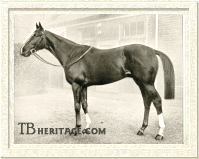
Call Boy
| |
CALL BOY was Hurry On's third and last Derby winner, and the one who did not run for Darling and Lord Woolavington. He was bred by Frank Curzon, a successful entertainment entrepreneur, at his Primrose Cottage Stud, and was trained by John Evelyn Watts, a former jockey who had worked as a trainer for the German government stud prior to World War I, and who served in that war for four years with the Suffolk Yeomanry. After the war he established a training stable, Lansdowne House, at Newmarket, and in 1922 accepted the trainer's post with Curzon. |
Watts would later train for Marcel Boussac in Chantilly, where he schooled the aforementioned Coronach daughter, Corrida, for her two Arc triumphs, and after World War II he trained for H.J. Joel at Foxhill, training the filly Picture Play for a win of the 1944 1,000 Guineas.
Call Boy, born in 1924, was the fourth foal of Comedienne, a mare from the first crop by Bachelor's Double, who was bred by Sir Henry Greer in Ireland, and purchased by Curzon for 130 guineas. She won four small races in succession as a two year old. Her first foal died as a yearling; her second, a filly, was a non-winner in her one start at age two, but later was second dam of 1941 1,000 Guineas winner Dancing Time, herself ancestress of some classic winning speedsters in Ireland and Italy. Comedienne's third foal, Comedy King, by Son-in-Law, was a good horse that won the Great Yorkshire Stakes and a number of other good races.
Call Boy was rated fifth in the 2 year old Free Handicap. He had run third to Sickle and The Satrap in the July Stakes, his first race, and second to Damon in the Champagne Stakes. He won the 5 furlong Linton Stakes over moderate company, and then the Middle Park Stakes over Sickle and Birthright; in the latter race he was receiving 3 pounds from each, and beat them by only a head. His prospects for the three year old season then, were good, but not great; despite this, Curzon refused offers on Call Boy, stating "I shall regard a repetition of the offers I have received as an insult. I know all the risks attendant on the possession of a high-class two-year-old, and I am prepared to accept them myself."
Call Boy came to his first race at age 3, the 2,000 Guineas, as favorite; Curzon, determined that Call Boy should be a "public" horse, kept all his trials open, and when formally tested against his elder half-brother, Comedy King, easily beat him. Curzon's easy public manner made him a favorite of the crowd as well. Call Boy was beaten in the last stride by a short head by the Pommern son, Adam's Apple, although many considered the race a dead-heat. His next race was the Sledmere Plate at Newmarket, which he easily won by four lengths against a moderate field. He won the Derby, leading, except for a few strides towards the end of the race, from start to finish, beating what has generally been considered a fairly modest field of 22 other horses. Curzon, who was already seriously ill with heart problems, slowly led his winner to the unsaddling enclosure, and it took him some time to ascend to the Royal Box to receive the King's congratulations. Two weeks later he was dead of a heart attack.
Curzon's death voided Call Boy's engagements, including the St. Leger, and although fresh engagements could have been made, in the confusion following Curzon's death, that did not happen, and Call Boy never again ran. A syndicate of Argentinian breeders offered to purchase him for £40,000, and the French breeder and racehorse owner Jefferson Cohn (owner of Teddy), offered £60,000, followed by an offer of £100,000 for all of Curzon's bloodstock. In the end, Sir Harry Mallaby-Deely, Curzon's brother, purchased the horse for £60,000, stating "I have bought Call Boy not because he is a great horse but because he was my brother's." Mallaby-Delly paid an additional burden in taxes on the horse, who was sent to Wyck Hall Stud at Newmarket to stand at 400 guineas the following season. Comedienne was purchased by Sir Victor Sasson for £11,000, and Call Boy's half-brother, Comedy King was purchased to France in the Newmarket October sales for a 4,000 guineas price tag. In the stud Call Boy proved to be almost sterile. |
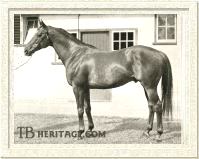
Precipitation
| |
PRECIPITATION, a non-classic winning son of Hurry-On, was destined to continue the European branch of the Matchem sire line. His sire was twenty years old when he was born, in 1933. His dam, Double Life, was another mare by Bachelor's Double. She was bred by J.R. Ryan in Ireland, was bought as a yearling for 600 guineas by Lady Zia Wernher, a racing enthusiast and successful thoroughbred breeder and owner. |
Double Life was a small, slight chestnut filly who showed herself to be good and game at age three. Her four race winning streak included the 10 furlong Duke of York Handicap, won by a length and a half, and a brilliant first in the one mile Cambridgeshire Stakes handicap, carrying a ten pound handicap, in which she beat a field of thirty-six, the biggest number of runners since 1878.
Double Life became a successful foundation mare in Lady Zia's Someries Stud at Newmarket, where Precipitation, her second foal, was born. Three of her daughters produced good winners, and one, Doubleton became second dam of the top 1955 filly Meld, also bred by Lady Wernher. Four of Double Life's sons became stallions, three of them in the Someries Stud: 1944 Coronation Cup winner Persian Gulf, sire of a classic winner and some top stayers, the stayer Casanova, sire of an Irish classic winner and later of winners in Sweden and Poland, and Precipitation.
Like Hurry On, Precipitation was a big, immature two year old, and he was not started until age three. He wasn't quite fit for his first race, and ran unplaced. In his next race, the Royal Standard Stakes over 10 furlongs, he won, but was disqualified for crossing. He then won three 1-1/2 mile races in succession. An infection on his heels and pasterns from Trombicula (mites), side-lined him for the St. Leger, but he easily beat that race's winner, Boswell, in the Jockey Club Stakes three weeks later. He was ranked third, two pounds below Mahmoud, and one pound below Pay Up in the Free Handicap. At age four his most impressive win was the Ascot Gold Cup against a high-class field, where he beat the Coronation Cup winner Cecil by two lengths, and the previous year's Gold Cup winner, Quashed, by six lengths. He was retired to stud with £18,419-1/4 in earnings, a significant sum for a non-classic winner.
He entered the stud with a fee of 300 guineas, and a book filled for three seasons in advance. Precipitation sired four English classic winners and a great many more that were, like him, high-class stayers; his top thirteen money winners, all of which won over £5,000, all won at least once at distances between 12 and 19 furlongs. He was second on the leading sires list in 1946, and he would have been at the top in 1948 if he had been credited with the winnings of Supreme Court. He died on March 9, 1957 at Someries Stud, where he spent his entire racing and stud career.
Precipitation's sons were better than his daughters on the turf and in the stud, and generally were a source of stamina. Airborne (1943) won both the Derby and St. Leger, but was a disappointment in the stud. Premonition, who won the St. Leger, likewise failed to get a sire son or any classic winners. Preciptic, a sturdy stayer who won fifteen races, went to stud in Ireland, but also was not a particularly successful sire. St. Leger winner Chamossaire, later sire of Irish Derby winners Chamier, Your Highness, and Santa Claus (also an Epson Derby winner), and of St. Leger winner Cambremer, became a leading sire in England. Sheshoon, also a St. Leger winner, was a leading sire in France; his son Sassafras won the Arc, and Pleben the Grand Prix de Paris, and in England Mon Fils won the 2,000 Guineas. Supreme Court, who won £36,949, was most likely by Precipitation, but he also was not a great success at stud. Precipitation was highly influential in New Zealand and Australia, where three sons became champion sires and had a great impact on bloodstock there in the 1950s and '60s. Precipitation also made a major contribution to the sporthorse world by siring Furioso, who in France got ten Olympic show jumpers and the extremely influential warmblood sire, Furioso II. Despite Precipitation's success in getting good sire sons, this branch of the Matchem sire line is again in jeopardy. |
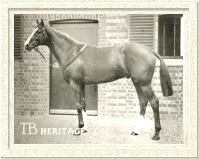
Press Gang
| |
PRESS GANG (1927) was a very good two year old, rated second the the Free Handicap, just below Diolite, and above Blenheim. He was out of the war time Derby and St. Leger winner Fifinella, who had been purchased by Lord Woolavington for 12,000 guineas in July of 1925. She had produced four winners, and her colt of 1924, Messenger Boy, by Hurry On, was also to become a winner, although later developed into a roarer and was sold to Kenya. |
Press Gang was another sturdy chestnut Hurry On son. Under Darling's stewardship, he won three races at age two -- the Rous Memorial, the Middle Park Stakes, and the Hurst Park Great Two-year-old Stakes -- and placed second in his other two races, the Redfern Plate at Kempton Park, and the New Stakes at Ascot.
Because the Baron had had no success with Fifinella's 1925 and 1926 foals (by Tetratema and Gay Crusader, respectively), and because Press Gang's brother, Messenger Boy, had developed wind problems, he did not enter Press Gang for the Derby or St. Leger, but he was nominated for the 2,000 Guineas, which he was expected to win up until the Nonsuch Stakes over a mile and one-half, run a week before the Guineas. In that race, he was a 6 to 5 favorite, and appeared to be well-placed to win during the race, when he ran out of gas and came in fifth. He was then withdrawn from the Guineas. His next race was the Jersey Stakes at Ascot, where he was beaten by a neck by an indifferent racer. He regained some of his two-year-old form eventually, and won the Princess of Wales's Stakes over 1-1/2 miles by two lengths, beating the year older, favored Bosworth, who was conceding 9 pounds. His next and final race was the one mile Gordon Stakes, where he ran a dead-heat with Ut Majeur. Press Gang, rated co-champion 3 year old with St. Leger winner Singapore, was retired to Lavington with a stud fee of 250 guineas. He did not make a significant impact in the stud. |
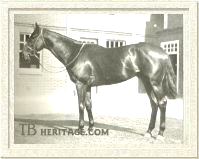
Hunter's Moon
| |
HUNTER'S MOON (1926) was out of the high-class racemare and great broodmare, Selene, dam of Sickle and Pharamond. Bred and owned by (17th) Lord Derby and trained by George Lambton, he ran twice as a juvenile, placing second once. At age three he began by running second in the Union Jack Stakes at Liverpool, receiving 16 pounds from the winner. A month later he won the Spring Stakes at Newmarket, receiving 10 pounds from the colt Haste Away, whom he beat by a head. He ran fourth in Mr. Jinks' 2000 Guineas and in the ten furlong Newmarket Stakes, he was placed first by a short head in a thrilling three-horse finish with Mr. Jinks and Midlothian. |
His schooling for the Derby was light, because he was shin sore, and he eventually ran fourth in that race. He won his next race, the Gratwicke Stakes, by a head, and was withdrawn from the St. Leger, his shins not holding up to the hard ground that summer.
Lord Derby sold him to Argentina, where he became a highly influential sire. He was later sold to Brazil, where he continued to be incredibly influential, both there and in other South American countries, notably Peru and Chile. Hunter's Moon offspring included Helium, a great stayer that won the Gran Premio Brasil over 3,000 meters; the champion filly Hear!; Hulia, another great filly that won classic races; Halifax, another grand stayer and winner of races up to 4000 meters and later a top sire in Chile; Half Crown, winner of la Polla de Potrancas and other good races; Fairplay, winner of top races in Brazil. In Chile, he got Hamlet, a classic winner, later a top sire and broodmare sire; Carnaval, an excellent stayer who became a top sire of classic winners; Holy Smoke, a winner of the Argentinian Jockey Club Stakes in record time, and later a good sire; Taitai, a brother of Hamlet, a good winner in Chile, and a sire of sires. Postin, who won classic races in Peru, became one of the most influential sires in that country's history; in the 1955 Peruvian Derby, all the runners were sired by him, and this occurred again in Peru's Gran Premio Nacional in 1956.
Hunter's Moon was also a top broodmare sire. His daughter Himalaya was the dam of Endeavor, the champion older horse in Argentina, who was later exported to the U.S. where he became the sire of Porterhouse, Pretense, and Prove It, among others. Other daughters produced Et Bien!, the champion older mare in Argentina, and winners of top races in Argentina, Brazil, Uruguay, and Bolivia.
Other sons of Hurry On who made marks in turf and/or in the stud included the following: |
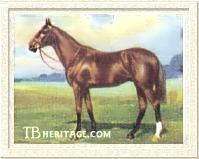
Town Guard
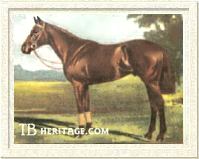
Diligence
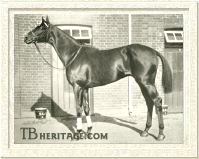
Cyclonic
| |
TOWN GUARD (1920), out of a William the Third mare, William's Pride, was bred and owned by Woolavington. He was a very good juvenile who won the Ascot New Stakes, the Gimcrack Stakes, and the National Breeders' Produce Stakes, and three other races, for a total of£11,016. Sent to France for stud duty, he was near the top of the sires list there four times; later he became a good sire in Argentina.
DILIGENCE (1919) was another chestnut son of Hurry On, out of Ecurie, by Radium. Bred by the National Stud at Tully in Kildare, Ireland, he was leased to Lord Lonsdale, who ran him throughout his career. He won four races at ages three and four, including the Newmarket St. Leger and the Sussex Stakes; he was slated for the Ascot Gold Cup, but met with a career-ending accident at Beckenham two days before the race, and was sent back to Tully where he stood at stud for a few years at a fee of 48 sovereigns. He got some good winners, including Dick Turpin (Chester Cup), and Daumont, (Coronation and Criterion Stakes), and was eleventh on the leading sire list in 1934. His daughter, Clarence (1934), produced the great filly Sun Chariot (1939) to Hyperion, unbeaten at age 2 and winner of the 1,000 Guineas, Oaks, and St. Leger stakes, and later dam of Blue Train and Gigantic. Another Diligence daughter, Whirling Dun (1934) produced the champion 2 year old The Pie King. The Diligence daughter Fairy Godmother (1929) produced the modest racehorse Fair's Fair, who, in New Zealand, became a leading sire twice, and leading broodmare sire three times.
Diligence, along with another Hurry On son, Cyclonic, were part of a huge consignment of fifty-nine stallions and colts and a number of broodmares purchased by Russia in 1935. Other Hurry Ons included in the purchase were Accelerator (1931), Garryclogher (1931), and a Diligence son, Aristotle (1926).
|
Of these CYCLONIC (1925), a chestnut out of the Corcyra daughter Volcanic, was a good runner. His dam, bred by Sir John Robinson at Worksop Manor, had won four races as a juvenile. She was purchased by J.S. Courtauld, for whom she produced a number of foals, Cyclonic, her third, was her best. At age three he won the King Edward Stakes at Ascot and two other races, and ran third to Fairway and Palais Royal in the St. Leger. At age four won the fourteen furlong Jockey Club Stakes by a short head in an exciting race. He retired to stud at Heath Farm, Newmarket, after a loss to Fairway in the Champion Stakes; he won £10,402 and four races in his eighteen starts over three seasons. In Russia he did very well, and was champion sire there.
NESIOTES (1923), bred by Federico Tesio from his mare Catnip (dam of Nogara and so second dam of Nearco), was another big colt by Hurry On. He won at ages two, three and four, including the Premio Omnium and the Premio del Sempione (twice). In the stud he sired the good stakes winner Fante and some other good horses, including the jumper Maenio, a winner of the Grand Premio di Merano. Another Hurry On son who got good jumpers was the chestnut Werwolf (1919), out of an Isinglass daughter. He won two races at age two. In the stud, he got some modest winners on the flat, almost all stayers, among them the long-running gelding Free Fare, and Immune, who won in Sweden and Denmark. He also sired a series of consistent winners over fences; his 1933 son, Bogskar, won the 1940 Grand National, and another son, Silver Fame (1939), won the 1951 Cheltenham Gold Cup.
Several Hurry On sons made an impact in Australia and New Zealand. HUNTING SONG (1919) was champion sire in New Zealand in six successive years in the 1930s, getting top stayers and also some very good steeplechasers and hurdlers. DEFOE (1926), at stud in New Zealand, got the champion Defaulter who became a good sire. EXCITEMENT (1927), at stud in Australia, sired the champion stayer and Melbourne Cup winner Russia, among other winners, and Lord Warden (1925), also in Australia, got some good stakes winners there.
Hurry On sired four classic-winning daughters, and some other filly winners, and overall, were just as good on the turf as good as his sons. In the stud, his fillies were exceptionally good producers with all kinds of stallions, and their successes propelled Hurry on to the top of the Broodmare sire list three times; he was second twice, and third three times, in all he was near the top of the broodmare sires list thirteen years. |
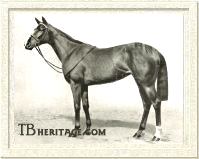
Plack
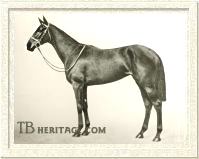
Cresta Run
| |
PLACK (1921) was a huge chestnut filly out Groat, an unraced daughter of the modest stallion Junior. She was bred and owned by the (5th) Earl of Rosebery, and trained by Jack Jarvis, with whom Rosebery had a long a fruitful association. Jarvis sent out nine classic winners during his long career as a trainer, and Plack, like most of the Jarvis horses trained for the Earl, had a fairly demanding schedule during her three seasons on the turf.
Sent out six times at age two, she won the Lennox Plate for maidens at Hurst Park, the Rous Plate at Doncaster, beating eight runners while conceding 10 pounds, and Ayr's one mile Land 'o Burns Nursery Handicap, in the latter giving the field 19 pounds. She ran second in the Middle Park Stakes, beating by 1-1/2 lengths by Diophon, who was later winner of the 2,000 Guineas, and ran third in the Great Kingston Plate, beaten by a neck. At age three she ran seven times. She beat Mumtaz Mahal and Straitlace in the 1,000 Guineas, and then ran second to Straitlace in the Epsom Oaks. Her other two wins were the Newmarket Oaks and the Jockey Club Cup. She ran second and third, respectively, in the Atalanta Stakes at Sandown and the Brandon Handicap at Newmarket, again carrying the top weight. |
At age four she ran nine times, and won twice: the Chippenham Stakes against one other horse, Eaglestone, and the Southfield Stakes. She ran second in the Caledonian Hunt Cup in Scotland, and ran third in four big races, the Coronation Cup, the Hardwicke Stakes, the Doncaster Cup, and the Jockey Club Cup. In all, she won £11,000. Her best foal was Coin of the Realm, by Phalaris, who won the Rous Plate at Doncaster and was later a good producer.
CRESTA RUN (1924) was Hurry On's second classic-winning filly. She was out of Bridgemount, by Bridge of Earn, who ran five times in Ireland as a juvenile, winning four of her races, including the Phoenix Plate. Cresta Run was bred and owned by Colonel Giles Loder, the nephew of Colonel Eustace Loder, who had owned the great racemare Pretty Polly, and Cresta Run was related to this great mare in that her third dam, Adula, was a sister to Pretty Polly.
Cresta Run was a big, muscular filly with an excitable temperament--her trainer called her "irritable and capricious" -- which sometimes cost her her races. She was a good two year old when she cared to be, rated top in the Free Handicap for fillies, with two wins, the Highclere Nursery and the Imperial Produce Stakes at Kempton. She ran last in the Middle Park Stakes, her trainer, Peter Gilpin, stating "she would not go at all." In her other races at age 2, she "behaved very badly" in the Queen Mary Stakes at Ascot; "took no part in the contest" in Sandown's National Breeders' Produce Stakes," and "ran little, if anything, better than previously" at York, when she ran fourth, even receiving 18 pounds. Over the winter she presented erratic works, "alternately ...well and execrably." Her first race of her three-year-old season was the 1,000 Guineas, which she easily won by two lengths over a field of 28. She ran dead last in the Epsom Oaks, after a delay and two false starts, trembling before the race started, and never "showing the slightest inclination to race, she finished an ignominious last." She was sent to Ireland to contest the Irish Oaks, but finished fifth, and she was promptly retired to the stud where she was not particularly successful.
|
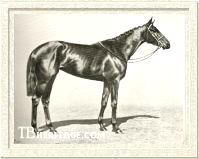
Toboggan
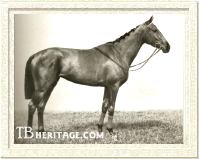
Pennycomequick
| |
TOBOGGAN (1925) was the best racing daughter of Hurry On. She was out of Glacier, a mare by St. Simon who had won a nursery plate at age 2 and once, a handicap at age three, in her thirteen starts that season. Glacier was much more successful in the stud; in addition to Toboggan, she produced Crevasse, who won the Liverpool Autumn Cup and three other races; Silurian, a good stayer who won the Doncaster Cup and ran second in the Ascot Gold Cup, and Blue Ice, winner of the Yorkshire Oaks. In appearance, Toboggan strongly resembled St. Simon, rather than the more sturdily built Hurry On. But, as she was to demonstrate on the turf, she was amply gifted with Hurry On's stamina.
Toboggan was bred and owned by Edward Stanley, (17th) Earl Derby who owned the Knowsley Stud in Lancashire and Stanley House stud and stable at Newmarket. Derby also owned the Hurry On colt Hunter's Moon, but Toboggan was trained by Frank Butters, rather than George Lambton, who had retired to the position of Derby's racing manager, and it was Butters, as trainer at Stanley House, who propelled Derby to the top of the leading owners lists in 1927 and 1928.
|
Another big, growthy filly, Toboggan wasn't started until August of her two year old year. She ran third in her first effort, a maiden plate at Kempton, and then, after having "had her eyes opened," she went on to win her next race, the Champion Breeders' Foal Plate at Newmarket. In the fall, she won her next two races, at Newmarket, the Boscawen Stakes, by four lengths, and the Dewhurst Stakes by six lengths. She was rated the top filly in the Two Year Old Free Handicap, with the Captain Cuttle daughter, Scuttle, placed just below her.
Toboggan wasn't ready for her first race at age three, the 1,000 Guineas; in a trial over a mile prior to the race, it was clear she wasn't yet fit enough, finishing last of four runners, but she ran anyway, and came third to Scuttle and another good filly, Jurisdiction. Between the Guineas and the Epsom Oaks, she improved dramatically, and in the Oaks she was never headed, winning from Scuttle by four lengths, and six lengths more ahead of the rest of the field of thirteen fillies. Her next race was the one mile Coronation Stakes, again easily beating Scuttle into second place; the third place filly in that race was another Hurry On daughter, Romany Queen. After that, she had a walk over in the Welsh Oaks. She ran poorly -- third -- in her next race, the St. George Stakes at Liverpool, attributed to some jostling and bumping. Her last race was the fourteen furlong Jockey Club Stakes, which she entered with a suspect tendon. The nine horse field included the Hurry On son, Cyclonic, who had run third in the Derby, and the good five year old mare, Foliation, just off a win of the Hardwicke Stakes, who gave Toboggan 9 pounds. Toboggan won by two lengths. After the race it was clear her tendon trouble would stop any further racing that year, and since she had been intended for the stud at the end of the season, anyway, that was her final appearance on the turf. In all she won £25,050 in her two years on the turf.
In the stud, her only good race horse was her son by Gainsborough, Bobsleigh (1932), who won the Richmond Stakes and the Newmarket Stakes. He later sired a Grand National winner, Oxo. Toboggan's daughter, Hydroplane (1938), by Hyperion, ran seven times at ages 2 and 3, and placed only once at age 3. She was purchased by Warren Wright in 1941, one of two Hyperion daughters he bought that year for Calumet Farm in the U.S. At Calumet, Hydroplane produced two modest winners, Fly Off (by Sun Teddy), and Mermaid (by Blenheim). Her third foal was the dark bay colt Citation, the American Triple Crown winner and a great stayer who won a number of other top races. The 1981 Gate Dancer, who won the Preakness Stakes, and the outstanding race filly Davona Dale (1976) both descend from Hydroplane through Citation's sister, Sienna.
The brown PENNYCOMEQUICK was Hurry On's last classic-winning daughter. She was out of the Polymelus daughter, Plymstock, whose dam, Winkipop, had won the 1,000 Guineas. Winkipop's dam, Conjure, was the first thoroughbred owned by Waldorf Astor, 2nd Viscount, an American who had inherited the title from his father. She had been purchased for £100, when Astor was still a student at Oxford; he was hoping to ride and win the Grand National with her. When health problems forced him to set aside this fantasy, he put Conjure in the stud, where she produced a series of good winners on the flat, rather than the expected jumpers, her daughter Winkipop becoming his first of nine classic winners of eleven classic races. All but one of Astor's classic winners were homebred. Pennycomequick, a product of four generations of Astor breeding at Cliveden Stud, was the fourth winner and fourth foal of her dam.
Pennycomequick had an accident early in her two year old season, and did not start until the fall, when she won her only race that year, Newmarket's Dalham Stakes by five lengths, over seventeen other horses, in a canter. At age three she started by winning the Haverhill Stakes at Newmarket. She did not run in the 1,000 Guineas. She won the Epsom Oaks easily, and in a faster time than Trigo had won over the same course in the Derby, held two days earlier. She started favorite for the Ascot's Coronation Stakes, where she finished a poor fifth, later attributed to being "sexually amiss." She did not run again until the Doncaster St. Leger, where she again started as favorite -- the fourteen horse field included Derby winner Trigo, 2,000 Guineas winner Mr. Jinks, Grand Prix de Paris and French Derby winner Hotweed. She looked a winner, briefly, but ran out of gas two furlongs from home, and Trigo won, with Pennycomequick sixth. Her staying limit was now defined to 12 furlongs, and there were no further tests: in September she came up lame during exercise, and was retired from the turf to spend her broodmare days at Cliveden Stud.
She produced seven winners, her best being the Hyperion gelding, High Stakes, winner of 34 of his 55 races in his nine seasons on the turf, including the Great Yorkshire Stakes, Newmarket's Limekiln Stakes, and Newmarket's Lowther Stakes, all of which he won twice. She also bred the Blandford colt, Pound Foolish, who won the Princess of Wales's Stakes, and the Coronation Stakes winning colt, Sunny Devon, by Solario. Pennycomequick's daughter, Penicuik (1934), by Buchan, ran in the 1,000 Guineas, the Coronation Stakes and the Falmouth Stakes at age 3, her only season, and was unplaced in all. In 1940, having produced one foal for Lord Astor, Newbattle, who later was sent to the U.S., Penicuik was purchased with a colt by Hyperion at side and in foal to Hyperion again, by A.B. Hancock, and sent to Ellerslie, his stud farm in the U.S., and in the fall was sold to Warren Wright of Calumet Farm. The yearling, Hyperionion was a good two year old, placing in two important juvenile efforts. The foal she was carrying when purchased by Wright was Pensive, the chestnut colt who won the Kentucky Derby and the Preakness Stakes.
Other good race fillies by Hurry On included FAIR DIANA (1927, out of Daughter-in-Law), winner of the Donaster Champagne Stakes; HURRYBELLE (1921, out of Mirobelle by Ladas), a winner of four races, including the Lancashire Breeders' Produce Stakes, and WILL O' THE WISP (1929, a sister of the aforementioned Town Guard), who won the Triennial Produce Stakes, was shared winner of the Yorkshire Oaks, and ran second in the Epsom Oaks. The latter was dam of the good producer Invisible, ancestress of Apparition, and Alpenhorn. The most immediately influential broodmare daughters of Hurry On included the following:
SLIP ALONG (1921) out of Pietermaritzburg daughter Veldt, was unraced. In the stud she produced ASSUERUS (1930, by Asterus), a good French stayer who won seven races, including Prix du Consil Municipal and Prix de la Foret, and ran second in the Prix de l'Arc de Triomphe.
HASTY LOVE (1922), out of Love Oil by Amadis, won four races in the course of three years on the turf, including, at age 2, the Claro Plate at Ripon, and at age 4, the Leeds Handicap. Her son, Medieval Knight, by Gay Crusader, was the champion juvenile horse of 1933; he was later sent to Australia where he had little impact at stud.
HASTILY (1926), out of the Junior mare, Henley, went unraced. Bred to Lancegaye, she was put in the Newmarket December Sales of 1930 from her Aston Park Stud home, owned by Clarence Hailey, where she was purchased on behalf of Frederick Armstrong of the Meadowview Farm in New Jersey for 1100 guineas. She dropped the Lancegaye foal in New Jersey in March: he was named Cavalcade, and was sold at the Saratoga yearling sales to Isabel Dodge Sloane for $1,200. Although he won only twice in a busy schedule at age two, he was rated second in the Experimental Free Handicap. At age three he won the Kentucky Derby, the 10 furlong American Derby, the Detroit Derby and the Classic Stakes at Arlington, beating Discovery. In all, he won eight of his twenty two races.
NUVOLONA(1926), out of the Tesio-bred, classy Italian filly Nera di Bicci, won three stakes races out of seven starts in Italy, at distances between a mile and one and one-quarter miles. In the stud she produced the Tesio-bred copper chestnut Navarro, a winner of eight top races in Italy who held the record for 3,000 meters for some years by winning the Premio Principe Amedeo in Turin. He became one of Italy's best ever broodmare sires. Nuvolona also produced Nicostrato, a top Italian racehorse, and two good producing daughters, Navaretta and Nera d'Avorio.
JIFFY (1931), out of the Junior mare Juniata, was a modest race horse, who placed second in seven starts as a juvenile, including Newmarket's Abingdon Mile Nursery, and ran third three times in her five starts at age three, two in maiden plates. In the stud she produced nine winners for Lord Rosebery; her best was Ocean Swell, by Blue Peter, a great stayer, who won six races, including the Derby, the St. Leger, the Jockey Club Gold Cup over 2-1/4 miles, and the Ascot Gold Cup. He was a disappointment at stud, and also died relatively early, at the age of 13. Jiffy's daughter, Iona (1943, by Hyperion), won the Lingfield Oaks Trial Stakes, and ran second in the Oaks; she was second dam of Kentucky Derby winner Tomy Lee; the great American race filly Genuine Risk also descends from Iona.
INSTANTANEOUS (1931), out of Picture, a half-sister to Pennycomequick by Gainsborough, was second in three of her four races at age two, including the ten-runner Molecomb Stakes won by Light Brocade. At age three she won the Haverhill Stakes at Newmarket and ran third in the Oaks, won by Light Brocade. She bred six winners, the most important being Court Martial, by Fair Trial, who won the 2,000 Guineas and the Champion Stakes and was twice leading sire in England.
INDISCRETION (1932), out of Brig O' Dee by Bridge of Earn was an extremely temperamental filly--worse, even, than Cresta Run, whose dam was also by Bridge of Earn. She flat out refused to start in three of her four races. Rushed into the stud, she was bred at age three to Sandwich and sold to France for 600 guineas. Then she went and became an exceptionally good broodmare, dam of nine winners, some of which ran in both England and France. Her daughter, Imprudence, by Canot, won major races on both sides of the channel, including the Prix Ladas, the French 1,000 Guineas, and the English 1,000 Guineas and the Epsom Oaks Stakes.
SUDDEN DAWN (1932), from Mountain Light by Juggernaut produced the big handsome chestnut Early Mist in 1945, by Brumeux, for breeder D.J. Wrinch. He puchased by J.V. Rank, for whom he won some steeplechases, bu Rank died in 1952, and he was sold to Dublin businessman Joe Griffin, for whom he won the Grand National of 1953.
James Buchanan, Lord Woolavington died in August of 1935, one week shy of his eighty-sixth birthday, leaving an estate of over seven million pounds, before taxes, and his bloodstock to his daughter, Catherine. Hurry On followed his owner in death the next year, age twenty-three.
--Patricia Erigero
|
|
|
|

